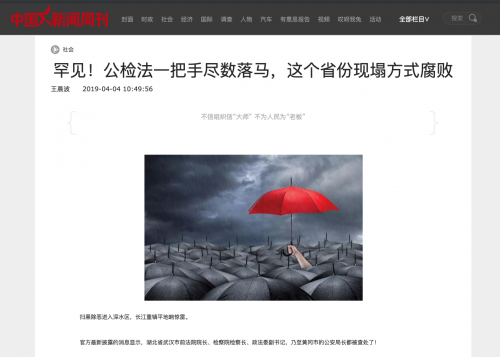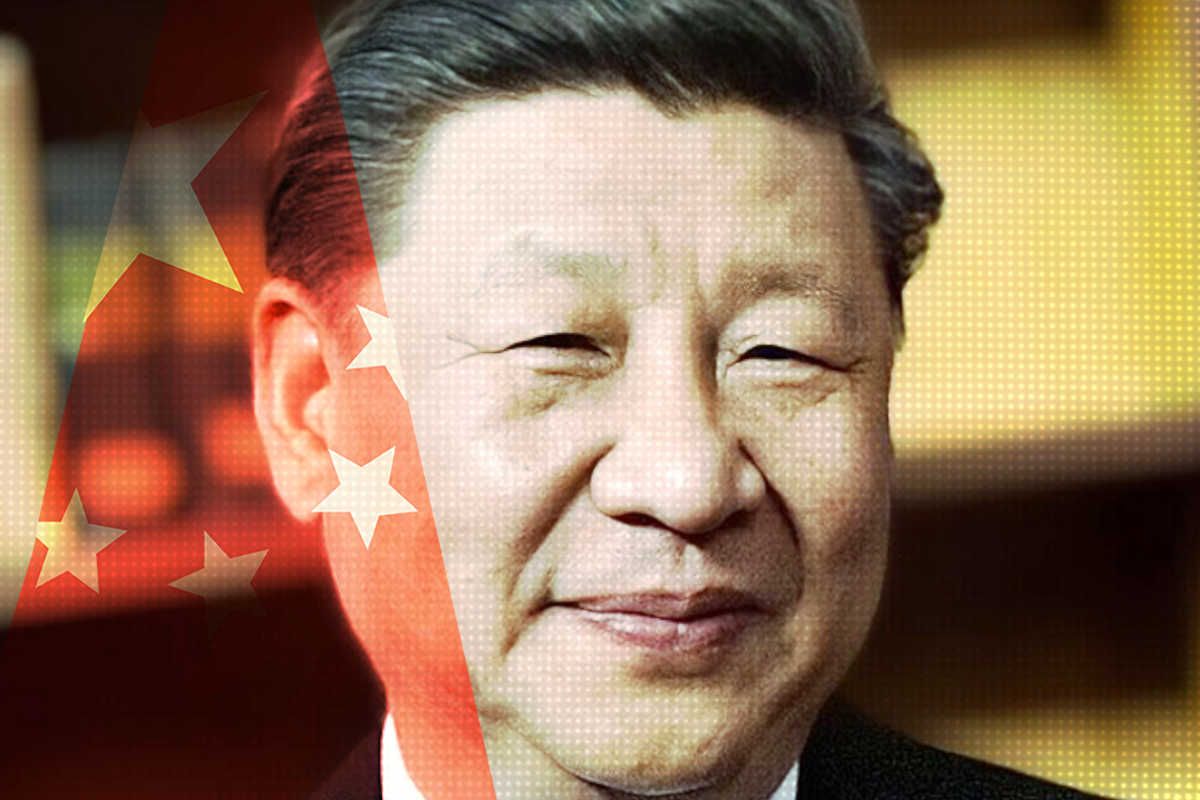Headlines and Hashtags
The black hole of copyright
This week (as we catch up on two weeks of news in the Chinese media) we find the issue of professionalism in the media creeping onto the agenda with a spate of stories highlighting sensational approaches to important stories as well as flagrant abuse of copyright. First, there was finger pointing over the opportunistic sharing by prominent official social media accounts, including that of the Party’s People’s Daily, of video footage showing the suicide death of a 17 year-old. Next, we had questions from a veteran journalist over a sensational and over-simplifying account by a prominent news magazine of a series of corruption stories in Hubei province. And finally, we had a scandal over the sale by Visual China Group of black hole images from the European Southern Observatory that were designated a free-to-share images under Creative Commons — which spiraled into wider questions about copyright protection in China.
Beyond these stories, don’t miss our fourth this week, about the disciplining of a broadcast official in Suzhou for using a Twitter account to access news stories from “illegal overseas websites.” That story is a sign of just how serious China is getting about restriction of access to foreign media, including through restrictions on VPN use.
________________
This Week in China’s Media
April 6-19, 2019
➢ China Newsweekly accused of sensationalism and in reporting corruption stories
➢ Chinese state media display unprofessionalism in sharing video of 17 year-old jumping to his death from Shanghai bridge
➢ Black hole image sold by Visual China Group sparks wave of discussion about copyright abuse
➢ Suzhou broadcasting official disciplined for accessing external internet through Twitter
➢ China National Library announces archive of Sina Weibo posts
[1] China Newsweekly accused of sensationalism and in reporting corruption stories
On April 4, the website of China Newsweekly, a leading Chinese news magazine, published an article called “Rare Sight! Top Officials from the Police, Procuratorate and Courts in This Province All Fall Together in Corruption Case” (罕见!公检法一把手尽数落马,这个省份现塌方式腐败). The article said that, “According to the latest official information, the former director of the court in the city of Wuhan in Hubei province, as well as the director of the procuratorate, the deputy secretary of the politics and law committee, and even the police chief of Huanggang [a prefectural-level city in Hubei], are all now under investigation!”
The suggestion from this prominent news magazine seemed to be that top provincial officials from the police and procuratorate in Hubei had been swept up in a rare anti-corruption action.

However, on April 6, veteran journalist Chu Chaoxin (褚朝新) posted to his personal WeChat account taking the China Newsweekly to task for its story. Chu noted that while the “this province” in the headline clearly referred to Hubei, in fact the “top officials” listed in the article had held city-level positions in the province. They included the former director of Wuhan’s intermediate people’s court, Wang Chen (王晨), the director of the Wuhan City People’s Procuratorate, Xun Guangjun (孙光骏), the former deputy secretary of the Wuhan politics and law committee, Zhou Bin (周滨), and the police chief of Huanggang, Wang Zhihuai (王治怀). These officials, Chu said, all came from very different jurisdictions and levels, and while Wuhan is Hubei’s provincial capital, these officials cannot be seen as reflective of politics at the provincial level. Huanggang, moreover,is merely a prefectural-level city, an even lesser concern. Why, then, Chu asked, had China Newsweekly muddied the story by reporting that “top officials from the police procuratorate and court all fall together” in “this province”?
The chatter surrounding the story and Chu’s response was a rare instance of discussion within China’s media concerning reporting on corruption and media professionalism.
KEY SOURCES:
China Newsweekly (中国新闻周刊): 罕见!公检法一把手尽数落马,这个省份现塌方式腐败
WeChat public account “Media Observer” (传媒大观察): 资深媒体人批评《中国新闻周刊》报道标题党不专业
WeChat public account “Chu Chaoxin” (褚朝新): 《中国新闻周刊》,时政新闻可不能这么写
[2] Chinese state media display unprofessionalism in sharing video of 17 year-old jumping to his death from Shanghai bridge
On April 17, surveillance cameras on Shanghai’s Hupu Bridge captured footage of a young man leaping off of the bridge after arguing with his mother and jumping out of the vehicle in which they had been riding. Immediately after the tragic incident, the mother could be seen in the footage crouching and weeping at the point where her son jumped. Chinese media, including many official WeChat accounts such as that of the People’s Daily, shared the video footage of the suicide as a sensational eye-catcher, without considering the broader social consequences.

Media researcher Wei Wuhui (魏武挥) wrote in response to the case that increases in suicidal behavior have been linked in studies to media coverage of suicide, and while media should play a role in reporting on suicide they must do so with great care and professionalism.Unfortunately, he said, domestic media in China have been backsliding on professionalism in reporting of these issues in recent years.
KEY SOURCES:
WeChat public account “Che Dan Ji” (扯氮集): 能让我尊重的新闻媒体 已经不多了
WeChat public account “People’s Daily” (人民日报):【荐读】17岁男孩母亲面前跳桥自杀!父母教育出了啥问题?
Baidu account “Sichuan Mobile Paper” (四川手机报): 痛心!因与母亲发生口角,17岁男生跳桥身亡,监控显示全程不到5秒
[3] Black hole image sold by Visual China Group sparks wave of discussion about copyright abuse
On April 10, the first images ever taken of a black hole were published on the internet by the Event Horizon Telescope imaging project. Soon after, internet users in China discovered that Visual China Group (视觉中国), the largest image distributor in China, was selling the black hole images online, and a wave of discussion over copyright abuse followed. As it became engulfed in online controversy, Visual China Group responded that its images had been obtained under non-exclusive editing license from its cooperation partner, AFP, which had sourced the images from the European Southern Observatory (ESO), involved in the Event Horizon Telescope imaging project. But ESO’s official website clearly stipulated that the images were under Creative Commons Attribution 4.0 International License, meaning that they were free to share with attribution.
Concerning the Visual China Group matter, ESO issued a statement saying that this sort of claim to copyright was illegal, and Visual China Group never reached out to ESO concerning use of the black hole images. Visual China Group eventually issued its own statement saying: “These problems reveal that we have weak links in management, and we apologize for this!,” VCG said. “At present, the company has taken measures to deal with the non-compliance pictures, and voluntarily close the website in accordance with relevant laws and regulations to carry out rectification, further strengthen corporate self-discipline, strengthen system construction, improve the quality of content review, and avoid similar situations.”
The scandal engulfing Visual China Group unfolded rapidly, progressing within 24 hours from exposure to damaging attempts at denial, to public apology and finally to the temporary shutdown of the website in order to conduct an internal review.
Party media were the last to follow suit on the Visual China Group story. On April 11, the official Weibo account of the Chinese Communist Youth League (@共青团中央) made a post in which it revealed that Visual China Group had placed its watermark on images of China’s national flag and national emblem. “So are the national flag and national emblem also copyrighted by this noble company?” the account asked. On April 14, the official account of People’s Daily Online (@人民网) called on Party-run media—known in Chinese as “mainstream media” (主流媒体)—to play a leading role in cleaning up copyright infringements in China and work toward a “People’s Visual Web” (人民图片网).
KEY SOURCES:
Baidu public account “China Economic Weekly” (百家号“中国经济周刊”: 视觉中国黑洞照片引发的商业图库整治风暴
Baidu public account “TMT App” (百家号“钛媒体APP”): 视觉中国被“从重罚款30万元”之后
Beijing Evening Post (北京晚报): 被指图库钓鱼 以诉代销 “黑洞事件”牵出视觉中国盈利链
Sina Weibo account “@ChinaYouthLeague” (新浪微博@共青团中央): 国旗、国徽的版权也是贵公司的?
[4] Suzhou broadcasting official disciplined for accessing external internet through Twitter
On April 4, the Suzhou Broadcasting System (SBS) issues a notice called “Concerning the Handling of Zhu Chengzhuo’s Discipline Violations” (关于朱诚卓违纪行为的处理决定), which said that Zhu Chengzhuo (朱诚卓), the deputy director of programming at the station’s multimedia desk, had registered the Twitter account “Alexzhuozhuchengzhuo” to browse and read “harmful information on illegal overseas websites” (境外非法网站的有害信息), and that he had been called in for questioning. The notice said that “the above-mentioned conduct by Zhu Chengzhuo is a serious violation of political discipline and political rules.”

Hongkong 01(香港01): 蘇州電視台高管使用Twitter瀏覽境外網站 遭警方傳喚並被撤職
[5] China National Library announces archive of Sina Weibo posts
On April 19, the China National Library announced that it had initiated an “Internet Information Strategic Preservation Program” (互联网信息战略保存)involving the archiving of 200 billion public blog posts from Sina’s Weibo platform from the launch of the platform up to December 2018, which would be preserved at the China National Library. The archive reportedly will include also 50 billion images, 400 million videos and around 500 billion comments and likes. The archive would continue to archive content from the platform in the coming years.
News reports on the new archive said that “Internet information has become a new form of human civilization and social memory, objectively reflecting changes in politics, the economy and society.”
There was no clear indication of whether the archive would include deleted posts from the platform. The news also prompted some discussion of the rights of users to their own posts within the archive, with some commenters responding that all users signed an agreement when opening their Sina accounts giving all rights to the platform operator.
KEY SOURCES:
WeChat public account “China Youth Daily”(“中国青年报“):2000亿条!微博全将被国图保存,网友:后人能懂我的梗吗?





















